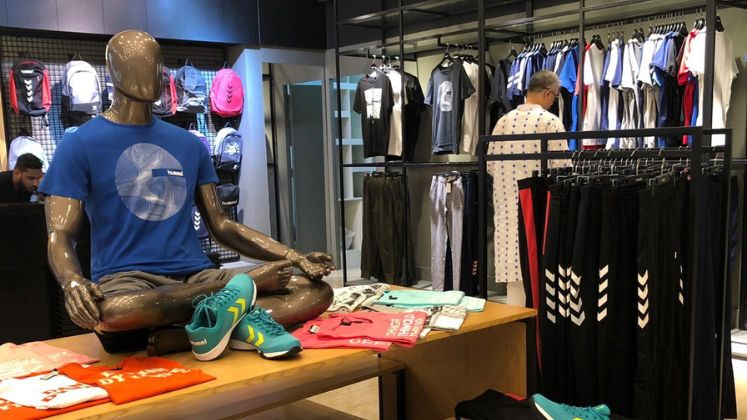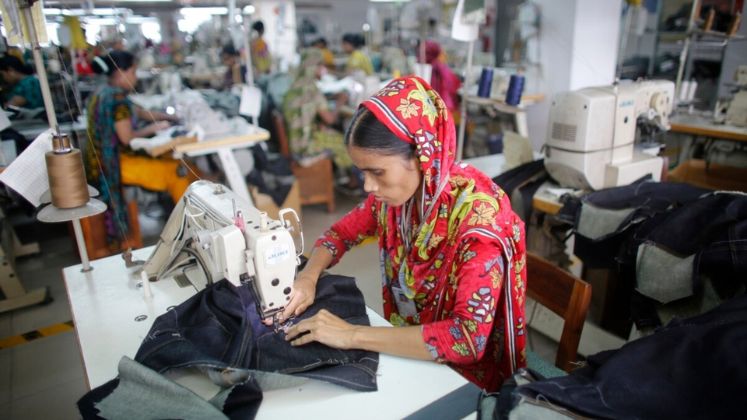2024 is going to be a highly crucial year for Bangladesh, especially for its RMG trade. Besides witnessing the impact of recent wage hike, the general elections are also scheduled in the beginning of the year and later BGMEA is going to have its elections. The impact of recent wage hike will also be visible in 2024. The last 3-4 years have been very eventful as well as challenging for the industry. Emerging from Covid to witnessing the impact of wars and most recently the recessionary trends, the RMG industry has overcome multiple storms and is expecting 2024 to be a normal year as overall the international scenario and apparel retail seem to be in a growth mode. In discussion with industry informed persons, business leaders and senior professionals, Apparel Resources brings for you a list of the key manufacturing trends that are set to take place in 2024.
-
Exports to grow from Q2
The three Is (Interest, Inflation and Inventory) seem to be on the right track with oil prices cooling down and US being out of recessionary trends. As US is set to have its general elections in November 2024, there will be good demand as experts believe that election year in US is going to be a booming one. So Bangladesh should have good orders in 2024. Inventories are now almost clear and so far there are positive indications with regard to the holiday season.
With regard to European Union (EU) facing high inflation, there are some positive signs for Bangladesh. Thanks to recent investments in higher value-added items, especially activewear, things seem to be improving as Bangladesh’s knitwear garment exports to the EU reached an impressive US $ 9 billion in the first nine months of 2023. This is like a significant landmark as Bangladesh has overtaken China as the leading knitwear garment exporter to the EU market for the first time, both in dollar value and volume. It is being also said that the after effect of war will start shading away significantly especially from second half of 2024.
Few of the companies have full orders booked for first three months of 2024, while on the basis of discussion with their buyers, many exporters believe that from April onwards, business will improve more and second half of 2024 will be really good.
Farhan Azim, Director, Azim Group says, “Overall export is likely to be slow in Q1, but it should be picking up from Q2 onwards as brands continue to increase their enthusiasm regarding locally sourced fabric.”
-
More thrust on jackets, tailored garments, formal suits; thrust on denim continues
Around 80 per cent of Bangladesh RMG exports are into Trousers, T-shirts, Sweaters, Undergarments, Shirts and Blouses. These product categories will remain in focus as usual.
Apart from these, tailored garments like jackets and formal suits are also important product categories for the country’s RMG trade and few of the companies are doing well in this segment. Thanks to continuous order shifting from China, jackets and formal suits in 2024 are expected to see more thrust. Industry stakeholders are of the opinion that the capacities in these niche segments will be fully utilised in 2024 and witness expansion too.
The global suit market, valuing more than US $ 80 billion as of 2022 (of which 25 per cent is contributed by USA alone), is expected to grow between 5-7 per cent CAGR by 2027. China currently accounts for lion’s share of the market (around 70 per cent by some version), followed closely on the heels by countries like Vietnam, Bangladesh, Cambodia, Taiwan and Turkey. Time and again, it has been highlighted that the industry needs to focus on producing and exporting more value-added garments. Suits are a better option in this regard as there are few of the factories producing suits reportedly at a command price of US $ 300 and above.
In the beginning of 2023, it was said that looking deeply into suit manufacturing in Bangladesh, one will see many of these have been established through JVs and this comes with transfer of technology and expertise.
It has been said that China will cede some market to low-wage countries with a higher skill set and Bangladesh will be the contender. In China, rising production costs and a shortage of skilled workers are also a concern.
Experts believe that industry’s focus on non-cotton-based athleisure items would lead to further successes in diverse product categories in the coming years.
Faheem Ahamed, Managing Partner, Welstand Apparel Limited opines that as of now, there are limited capacities in Bangladesh for jackets and formal suits while orders in these categories which earlier used to go to China, will now be diverted to Bangladesh.
Along with jackets, few of the companies are expanding in other niche segments like Wasim Zakariah, Director, Posh Garments shares, “In 2023, we have shipped a few orders for overshirts and fleece jackets. We plan to further expand our product range in the segment of lightweight jackets/overshirts and other value-added products like swimwear, beachwear.”
Denim is one of the core products for Bangladesh and players in this segment are continuously growing. Denim and denim-related products account for about one-fourth of Bangladesh’s total apparel exports and it needs to double its denim exports to achieve the US $ 100 billion export target by 2030. As there are massive efforts for product development in denim, workplace safety and sustainability in recent years, there are enough chances that denim export will grow in 2024 in good way.
Md. Alamgir, Sr. GM Marketing and Merchandising, Laila Group is of the view that the economic and political scenario in Pakistan, a leading player in denim, will also be in favour of Bangladesh and it will help to increase denim export of Bangladesh.
-
Market diversification: A strong push towards non-traditional markets
Exporters now get export incentives from the Government for catering to non-traditional markets, which is an added advantage.
Focusing on non-traditional and emerging markets offers new growth opportunities by tapping a new customer base while also diversifying the product range as per the country’s specific buyers.
There are more than 15 countries targeted as emerging markets, and in 2022, these have witnessed overall 29. 56 per cent growth. For example, in CY 2022, Brazil’s apparel import from Bangladesh increased by 60 per cent, Turkey’s by 118 per cent and that of Malaysia by 81 per cent. Similarly figures of other emerging markets are also positive like Japan’s import increasing by 29 per cent, Australia by 21 per cent, India by 61 per cent and Korea by 40 per cent.
Even as per the latest figures of BGMEA, compared to July-October 2022-23, in July-October 2023-24, there was overall growth of 17 per cent in Bangladesh’s apparel export to non-traditional markets. It is also worth mentioning here that amongst the emerging markets, exporters have to explore new avenues continuously as few of the countries like India not only have a huge market but are also growing.
In July 2023, there was buzz that Bangladesh’s apparel exports to India reached a milestone by crossing US $ 1 billion mark in the last fiscal year. And looking forward, the way India’s established retailers and emerging brands, start-ups are booming and expanding, sourcing products from Bangladesh, there should be massive growth in Bangladesh’s apparel export to India.
Mitali Fashions Ltd. (Mitali Group) has a strong thrust on emerging markets and will increase the same in 2024. Syed Ehsan Abdullah, MD says, “Focusing on emerging, non-traditional markets is now more than ever required so that the industry can have more business, different kinds of products and buyers. For us, South Africa, Japan, Korea and India are major focus regions.”
-
MMF and strong push for new developments
Companies having strong cotton base are not only focusing more on synthetics but also getting appreciation for the same.
For example, Fakir Apparels, renowned for its cotton-based garments, has successfully transitioned a significant segment of its product line to synthetic and synthetic blends, all the while retaining its established clientele. The company has earned the distinction of being the first in the country to receive the prestigious ISPO Award, for the innovative Calor Jacket – an avant-garde women’s piece that exemplifies its dedication to performance, sustainability and innovation in outdoor apparel.
This recognition positions Fakir Apparels as a trailblazer, dispelling the notion that high-end technicalwear manufacturing is exclusive to the Far East.
The company’s success mirrors a broader trend in Bangladesh, where manufacturers are making significant strides in the market.
Pakiza Knit Composite is also exploring technical fabrics and garments like sportswear and seamless. The company has plans to increase its tilt towards new types of products. MMF-based apparel such as activewear, sportswear, outerwear, swimwear and workwear are being recognised by the global players now.
Globally MMF-based apparel are on a roll as they accounted for US $ 222 billion of the US $ 440 billion global garments market last year compared to that of US $ 190 billion for cotton-based products. While Bangladesh’s almost 72 per cent of the garment exports continue to be for cotton-based apparel.
Syed M Tanvir, MD, Pacific Group insists, “Achieving the target of US $ 100 billion within a defined period is feasible if Bangladesh increases its share in cotton-based apparel to 20 per cent (from 16 per cent) and MMF-based apparel to 12 per cent (from the existing 5 per cent).”
Bangladeshi companies have gained technical know-how and increased investment in technology, particularly in the backward linkage industry making path easy for MMF.
-
Cost control: New technologies and higher efficiency, the only way out
There is hardly any segment where cost has not increased including the most recent wage hike which has now forced garment manufacturers to use new technologies, state-of-the-art infrastructure to improve efficiency. The idea is to save more than ever and at all the levels.
It is believed that advanced software be it cutting room solutions, product development, 3D sampling will be the focus areas for companies. A few of the leading exporters are already benefiting with advanced digitised developments in sales and marketing. Leveraging software solutions such as Clo3D, Browzwear and Adobe Substances, these companies have embraced a sustainable approach to sampling, effectively replacing physical sampling with virtual sampling. In 2024, more companies will come forward for such solutions.
While in machines, as usual high-end machinery, machines that cover more and more operations, help lessen dependency on manpower while offering significant advantages in terms of cost cutting, machines which are energy saving and easy to operate. Such developments are expected to take place at all levels of the production process.
It is also pertinent to mention here that in today’s scenario, none of the apparel manufacturers are looking for just a machine supplier; they want strategic partners who can help and support them in the growth journey, someone that they can completely rely upon.
Agreeing with this, Rakibul Islam Khan, MD, Pakiza Knit Composite says, “We will give a push to new technologies to improve our efficiency. We are currently working to fully automate our cutting department and chest printing department.” Just a few days back, the group installed a new yarn dyeing machine.
Atul Sangwan, Business Development Manager, Floreal Bangladesh (CIEL Textile) too adds that high efficiency and investment in automation are options to mitigate increased cost and they are focusing on that.
| It is believed that advanced software be it cutting room solutions, product development, 3D sampling will be the focus areas for companies. A few of the leading exporters are already benefiting with advanced digitised developments in sales and marketing. Leveraging software solutions such as Clo3D, Browzwear and Adobe Substances, these companies have embraced a sustainable approach to sampling, effectively replacing physical sampling with virtual sampling. |
-
Sustainability: recycled, alternate material are going to be at core
Bangladesh has created history by having maximum number of certified green factories and proved its dedication towards sustainability. Now the country has 206 such Leadership in Energy and Environmental Design (LEED)-certified green factories. And impressively it includes 76 platinum-rated and 116 gold-rated as well as 10 silver facilities. SM Sourcing, one of the leading apparel factories in Gazipur, has scored 106 points, the highest in the world as per US Green Building Council (USGBC).
Moving forward, now the industry has focus on recycled and alternate material as the entire globe is already focusing on these aspects.
Floreal Bangladesh has already initiated conversations with its buyers to shift towards using recyclable or degradable materials, helping to build trust and promote sustainability.
Bangladesh has taken the initiative to get a resolution on the use of natural fibres including jute adopted by the UN General Assembly every two years. These fibres can hold solutions to some such effects provided we could mobilise sufficient resources and expertise to develop and promote innovative solutions around them.
Even the country’s Ministry of Foreign Affairs, stands ready to work together with all concerned stakeholders to run a strategic campaign in the spirit of the UNGA Resolution.
There are chances of a package of fiscal facilities to enable emerging recycled cotton-fibre industries in Bangladesh to tap huge potential in apparel exports as The Bangladesh Trade and Tariff Commission (BTTC) has recommended for the same.
-
Local retail to flourish more with positive sign about economy
Despite challenges, the Bangladesh economy seems to be on the right track and it should have a positive impact on the country’s apparel retail business too.
There are reports saying that in 2024, the rising demand for goods, such as household items and clothing are expected to resuscitate the Asia-Pacific manufacturing sector, which plays a crucial role in the global economy.
And Bangladesh will be the second fastest-growing economy amongst the 46 countries next year, according to an annual economic outlook of Mastercard Economics Institute (MEI). The global economic research arm of Mastercard is also optimistic about Bangladesh’s GDP growth in the coming year as it forecasts the country’s real GDP growth to be at 6.3 per cent, near to that of the Asian Development Bank’s 6.5 per cent.
Moody’s Investors Service does not anticipate any significant changes in the Bangladesh economy’s creditworthiness or its ability to meet its financial obligations.
Maheen Khan, Founder-President, Fashion Design Council of Bangladesh believes that people in Bangladesh want to buy local products owing to their quality of fabrics and design.
Khalid Mahmood Khan, one of the co-founders of the fashion retailer Kay Kraft says that the recent festival season in Bangladesh has proved that there has been an increase in the number of shoppers this season compared to the previous one. Despite high inflation, apparel retailers are quite satisfied with the sales, compared to last year.
Statista’s report underlines that in 2023, the revenue in the apparel market in Bangladesh amounted to US $ 10.15 billion and the same is projected to experience an annual growth rate of 3.08 per cent (CAGR 2023-27).
-
Consolidation: Small units will close down
High cost is already a big issue for Bangladesh. Just a few days back, Mastercard projected a 7.3 percent consumer price inflation for Bangladesh in 2024, the fourth highest amongst 48 countries and the highest amongst South Asian countries.
On the other hand, as buyers are also under pressure and majority of them have not increased the price from many years, very less chances are there that they will increase the FOB price, so nearly all the stakeholders in the RMG industry are under pressure. It will have more negative impact on the small factories which can close as they are not in a position to bear the increased cost as they have limited resources.
More than 50 percent of garment factories in Bangladesh are small and medium-sized and such factories are under a continuous challenging phase since Covid.
Industry insiders believe that the overall bottom line will be impacted negatively by around 20 per cent, and in the long run, around 7 per cent to 8 per cent of factories may be closed as they will not be able to sustain the higher cost.
| High cost is already a big issue for Bangladesh. Just a few days back, Mastercard projected a 7.3 percent consumer price inflation for Bangladesh in 2024, the fourth highest amongst 48 countries and the highest amongst South Asian countries. On the other hand, as buyers are also under pressure and majority of them have not increased the price from many years, very less chances are there that they will increase the FOB price, so nearly all the stakeholders in the RMG industry are under pressure. |
Maisha Abdullah, Director, Mitali Group of Companies agrees that 2024 will be the toughest for small units and it can lead to their closure too.
Top Fashion Tech Trends Set To Rule 2024
- Gen AI is quite promising as an extension of AI technology
- IoT is the way forward for apparel and retail industry besides also streamlining operations in supply chain
- Immersive technology is set to be the foremost choice for fashion brands
- Unified commerce will get prominence in the upcoming year
- Data analytics will find widespread usage in retail and manufacturing businesses
- Digital wardrobe and metaverse will dominate in 2024 because of their ability in providing personalised consumer experience
- Traceability will lead to a more transparent and sustainable supply chain
-
Connected technologies boosting innovations in the knitting industry
External sensors, when equipped with circular knitting machines, give real-time information of the floor and Bangladesh’s RMG industry started realising this benefit in late 2023. Unlike apparel manufacturing shopfloor, the use of Internet of Things (IoT) in knitting units is still not normalised, causing 92 million tonnes of textile waste globally, that are generated annually.
Why these knitting/textile units need IoT or connected technology? Here is a simple answer – Textile units are still very fragmented in their processes and IoT and connected sensors can help mills identify hidden losses, resulting in improved process visibility, efficiency and waste reduction.
The companies have started implementing data-driven Production Planning System (PPS) as knitting technology companies have come up with their 3D software to better help factories in the product development process of knitted garments. These software solutions allow for easy creation and simulation of shapes and samples in 3D, while enabling quick design changes and feedback, reducing the need for physical samples and streamlining the production process.
The knitting garment manufacturers such as Pretty Sweaters (Bangladesh), Sonia & Sweaters (Bangladesh), Pakiza Knit Composite Ltd. (Bangladesh), Floreal and Elegant Overseas (India) amongst many other such giants have started using connected technologies in some way or other and are steering themselves away from the lure of low-cost machines to invest in high-tech connected technologies that offer maximum flexibility, support and intelligence while knitting.
-
Emerging dominance of e-Textiles in smart wearables
Smart Textiles include such textiles and their ensembles which are always responsive and adaptive at times. However, the current market trend is towards the adoption of e-textiles. Their widespread applications can be found in the health and wellness sector followed by sports and leisure. Furthermore, within e-textiles, development is ongoing for making textiles that get rid of any hard goods (metals/alloys/plastics/etc.). One can find increasing usage of conductive fibres and yarns over conductive inks and polymers. The lab scale research in the area of textile-based batteries is expected to be adapted by the e-textile ensembles conventionally powered by external batteries. On the other hand, amalgamation of diverse materials in such smart wearables draws critical attention to their end-of-life steps (recycling, disposal, etc.), when it comes to addressing the Sustainable Development Goals.


















